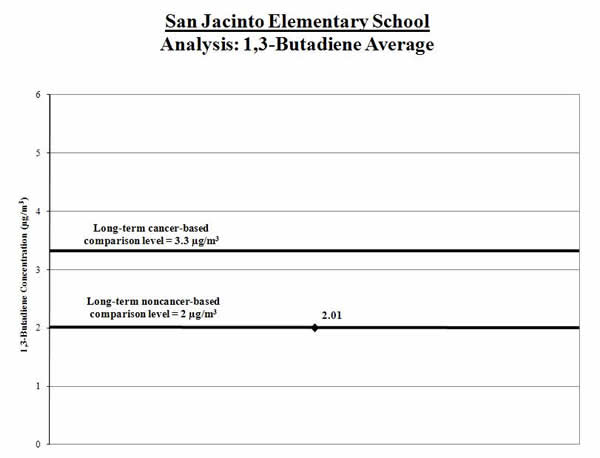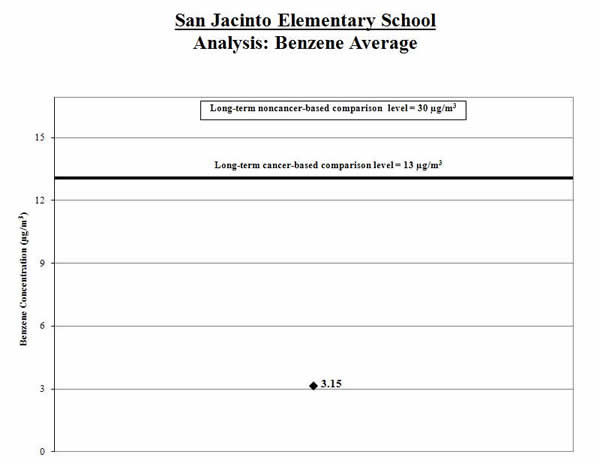Assessing Outdoor Air Near Schools
San Jacinto Elementary School and Deer Park Junior High School - Deer Park, TX
- Understanding the Monitoring Data
- Initial Sample Results
- Initial Analysis
- Additional Sample Results
- Final Analysis
Results and Analysis of EPA’s monitoring
EPA selected these schools for monitoring because they are located near a large petrochemical complex, as well as other industries which are sources of air toxics emissions. For the purposes of this study, results from the air monitoring at San Jacinto Elementary School are considered to be indicative of conditions at the nearby Deer Park Junior High School. Computer models were used to determine which air toxics may be present at elevated levels in the outdoor air near the school. These models showed that 1,3-butadiene, benzene, and benzo(a)pyrene could be present in the air around the school and prompted EPA to test to see if the levels present may be of concern.
| Primary Findings | Levels of 1,3-butadiene in the air at the school indicate a potential for concern for long-term, continuous exposure, due primarily to one elevated result. Levels of benzene and benzo(a)pyrene are below levels of concern for short-term and long-term exposure. Although the longer-term concentration estimate for benzene is below the cancer-based comparison level for benzene, in combination with the results for 1,3-butadiene, there is a potential concern for long-term, continuous exposure to the pollutant mixture. Results for other monitored air toxics do not indicate levels of concern. |
| Key Pollutants Monitored | 1,3-Butadiene. Inhalation may affect the reproductive system or cause leukemia if people are exposed to high levels. Benzene. Inhalation of benzene at high levels can affect the bone marrow and can cause anemia and leukemia. Benzo(a)pyrene. Inhalation of benzo(a) pyrene at high levels can cause cancer. |
| Next Steps | Based on these findings, EPA plans to conduct more air toxics monitoring for a longer duration at the San Jacinto Elementary School to better characterize the potential for exposures of concern in the community. EPA remains concerned about emissions from sources of air toxics and continues to work to reduce those emissions across the country, through national rules and by providing information and suggestions to assist with reductions in local areas. The Texas Commission on Environmental Quality (TCEQ) will continue to oversee industrial facilities in the area through air permits and other programs. TCEQ has also developed specific air monitoring comparison values for these key pollutants. |
Summary of Study Approach and Findings
Approach:
- A monitor collected air samples from September 4, 2009 through January 11, 2010 at the San Jacinto Elementary School in Deer Park, TX. For the purposes of this study, results from the air monitoring at San Jacinto Elementary School are considered to be indicative of conditions at the nearby Deer Park Junior High School.
- We posted individual air sample results on this website throughout the monitoring period to keep your community informed during the monitoring period.
- During the monitoring period, we evaluated the monitored concentrations to see if there was a concern from short-term exposures (e.g., several weeks).
- When the monitoring was complete, we analyzed the results to see if there was a concern from long-term exposures (over a lifetime).
- Also, when the monitoring was complete, we evaluated all the air samples from the on-site monitor. We also evaluated information on wind speed and wind direction from a weather monitor at the school, along with historical weather information and information about nearby sources of 1,3-butadiene, benzene, and benzo(a)pyrene emissions.
Findings:
- Levels of 1,3-butadiene in the air at the school indicate a potential for concern for long-term, continuous exposure, due primarily to one elevated result. Levels of benzene and benzo(a)pyrene are below levels of concern for short-term and long-term exposure. Although the longer-term concentration estimate for benzene is below the cancer-based comparison level for benzene, in combination with the results for 1,3-butadiene, there is a potential concern for long-term, continuous exposure to the pollutant mixture. Results for other monitored air toxics do not indicate levels of concern.
- The process to identify schools for monitoring relied on emissions estimates and other information. Ambient air monitoring at the school allowed measurement of what was actually in the air.
- The concentrations of benzene, and benzo(a)pyrene measured at the school are lower than those suggested by the information that helped identify this school for monitoring.
- Within the petrochemical complex, a process unit that produces 1,3-butadiene was shut down September 2009 through December 14, 2009. The portions of the chemical plant that either produce or process significant concentrations of benzene were shut down from September 24, 2009 through October 28, 2009. Another process unit handling benzene at the refinery was shut down for around 5 days starting September 27, 2009.
- Based on these findings, EPA plans to conduct air toxics monitoring for a longer duration at the San Jacinto Elementary School to better characterize the potential for exposures of concern in the community.
- Click here for additional information
How We Analyzed the Information We Collected at this School
The analysis considered whether the information collected at the school might raise concerns for the health of children or adults at the school. We looked at the following types of information:
- Measured 1,3-butadiene, benzene, and benzo(a)pyreneconcentrations and information on 1,3-butadiene, benzene, and benzo(a)pyrene
- Measured wind direction and wind speed at the school
- Information about nearby sources of 1,3-butadiene, benzene, and benzo(a)pyreneemissions
Analysis of Measured 1,3-Butadiene Concentrations:
1. Calculate the average: We calculated the average of the 1,3-butadiene measurements (shown by the black diamond in the graph below). We compared this average to the long-term comparison level (thick line on the graph below).
Result: The average 1,3-butadiene level for the samples collected was at the lowest long-term comparison level. There is a potential for health concern.

2. Calculate a range: To account for varying air concentrations of 1,3-butadiene, we calculated a range around the average. We did this by estimating high and low values that the longer-term concentrations might reach using common statistical tools. We compared the highest point in the range (called the “upper bound”) to the long-term comparison level.
Result: The high end of the range is higher than both the comparison levels. There is a potential for health concern.

Analysis of Measured Benzene Concentrations:
1. Calculate the average:We calculated the average of the benzene measurements (shown by the black diamond in the graph below). We compared this average to the long-term comparison level (thick line on the graph below).
Result: The average benzene level for the samples collected was below the long-term comparison level.

2. Calculate a range: To account for varying air concentrations of benzene, we calculated a range around the average. We did this by estimating high and low values that the longer-term concentrations might reach using common statistical tools. We compared the highest point in the range (called the “upper bound”) to the long-term comparison level.
Result: The high end of the range is lower than the comparison level.

Analysis of Measured Benzo(a)pyrene Concentrations:
Of the 11 samples collected, benzo(a)pyrene was not detected in 10 samples and was only detected in a very small amount in the one sample (0.0200 ng/m3). This value is well below the long-term cancer-based comparison level of 57 ng/m3.
Result: The benzo(a)pyrene levels for the samples collected were well below the long-term comparison level. The health concern from benzo(a)pyrene at this site is low.
Analysis of Measured Wind Direction and Wind Speed at the School
We took measurements of wind direction and speed every day during the sample period. We took special note of the wind speed and direction on the days we took measurements of 1,3-butadiene, benzene, and benzo(a)pyrene.
| What we looked at | What we found |
| We looked at whether the wind data taken on the days we took measurements of 1,3-butadiene, benzene, and benzo(a)pyrene are similar or different from the wind patterns during the entire sampling period. | We found the wind patterns taken on the days we took measurements of 1,3-butadiene, benzene, and benzo(a)pyrene to be somewhat similar to those observed during the entire sampling period. |
| We looked at whether the wind pattern during the sampling period is reflective of regional wind pattern over the long term. | Although we lack long-term wind data at the monitoring site, the historical data from the National Weather Service (NWS) station indicates that winds are predominantly from the south. During monitoring, winds were predominantly from the north where the source is located. |
Analysis of Information on Nearby Sources of 1,3-Butadiene, Benzene, and Benzo(a)pyrene Emissions
| What we looked at | What we found |
| Whether we could determine if the sources were operating as usual during the sampling period. | Within the petrochemical complex, a process unit that produces 1,3-butadiene was shut down September 2009 through December 14, 2009. The portions of the chemical plant that either produce or process significant concentrations of benzene were shut down from September 24, 2009 through October 28, 2009. Another process unit handling benzene at the refinery was shut down for around 5 days starting September 27, 2009. |
Levels of 1,3-butadiene in the air at the school indicate a potential for concern for long-term, continuous exposure, due primarily to one elevated result. Levels of benzene and benzo(a)pyrene are below levels of concern for short-term and long-term exposure. Although the longer-term concentration estimate for benzene is below the cancer-based comparison level for benzene, in combination with the results for 1,3-butadiene, there is a potential concern for long-term, continuous exposure to the pollutant mixture. Results for other air toxics monitored do not indicate levels of concern. |
|
| The nearby source of 1,3-butadiene, benzene, and benzo(a)pyrene has a Title V operating air permits issued by the TCEQ that includes operating requirements. |
Additional Information
Technical Report for School: Assessing Outdoor Air Near Schools: San Jacinto Elementary School (Deer Park, TX) (PDF) (35pp, 728k). The technical report is geared toward risk assessors, risk managers, and other regulatory agencies.
Background on School Monitoring Effort
General Questions and Answers for School Monitoring Effort
